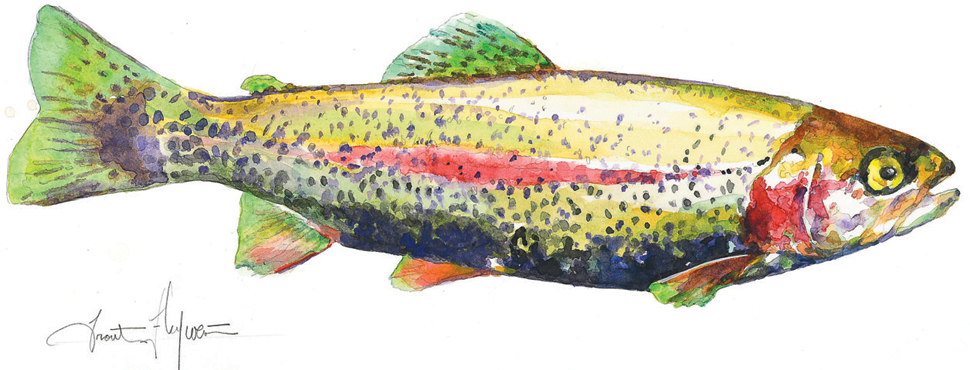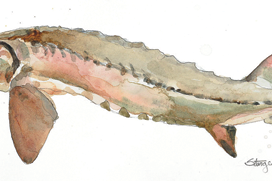Feeding the Future of Farm-Raised Fish
Idaho ranks as the nation’s top producer of farm-raised trout, and the heart of this industry lies in the Magic Valley off Highway 30 between Hagerman and Twin Falls. In the home of Thousand Springs State Park and the Snake River, mild year-round water temperatures and heavily oxygenated springs make conditions in this area ideal for rainbow trout. It’s no surprise, then, to find nearly 70% of the state’s commercial fish facilities clustered here.
Leo Ray, president and owner of Hagerman’s Fish Breeders of Idaho, has worked in the industry for nearly 50 years, raising trout as well as catfish, tilapia, sturgeon and tropical fish for aquariums. “When I first started, 1% of fish we ate came from farms,” he said. “Today, that’s 50%. They say in another 20 years, it’ll be 80% of our fish that come from farms.”
According to the Food and Agriculture Organization of the United Nations, there are several reasons for the increasing share of farmraised fish. Global demand continues to go up as the world’s population and per capita consumption of seafood rises. At the same time, seafood from “capture fisheries,” or wildcaught, areas is stagnating.
“So, the bottom line is that the only way the demand for seafood products can be met is by expanding aquaculture beyond where it is mintoday,” said Ronald Hardy, director of the University of Idaho’s Aquaculture Research Institute (ARI).
“We are kind of in a bind,” he added. “The only way we can produce more fish is by intensifying production from the freshwater resources we have or by expanding fish farming.” That means finding more sustainable, efficient ways to feed all those farmed fish.
At ARI’s Hagerman Fish Culture Experiment Station, fish nutrition is one of the main research activities conducted by Hardy and his colleagues. In the wild, big fish eat little fish, bugs and other living creatures, so in the aquaculture business, fish farmers traditionally use fish meal: dried, ground up bits of smaller fish, like anchovies and sardines.
But traditional methods of fish farming produce only about 265 pounds of edible meat per acre per year. In Idaho terms, that’s like growing three sheep on Boise State University’s “Smurf Turf ” every football season. And that’s not very efficient.
So nearly 20 years ago, Hardy and his colleagues started to develop fish feed that wasn’t nearly as resource limited—something they didn’t have to catch and also came in large quantities. They started with ground soybean meal.
But fish are carnivorous, so their digestive systems have not evolved to handle plantbased proteins. “Soybeans don’t have skeletons. They don’t have bones, and the bones in fish meal are a major source of minerals,” Hardy explained. As a result, the digestive systems of the fish he was working with
were failing.
To solve this problem, Hardy and his researchers developed a mix of plant meal and fish oil. These days, trout grown at the Station get a hearty, mostly plant-based meal of soybeans, corn and wheat, but it’s laced with a little fish oil to improve the mineral and nutrient balance and provide omega-3 fatty acids.
When the project began, it took nearly a year to produce a one-pound trout. Now, 16 years later, the experiment is yielding trout that can grow between two and four times as fast in the same amount of time.
Evaqua Farms in Filer has already started selling red and white rainbow trout, raised on a mostly plant-based diet developed by Hardy and the ARI, to wholesalers across the country. “Everything we’ve heard has been really positive,” said General Manager Jim Henderhan, of both the texture and taste of their farm-raised fish.
Meanwhile, Leo Ray of Fish Breeders of Idaho is conducting his own experiments on fish feed. He’s settled on a combination that utilizes byproducts from processing that takes place at his facility.
“When you fillet a fish,” Ray said, “The most you eat is 50%.” So, Ray’s operation will use the other half of the fish: the guts, heads and tails. It’s all ground up, put through an extruder and combined with a meal of grains: corn, peas, canola and soybeans.
According to Ray, the rewards could be less waste at the processing facility and less demand for small fish like anchovies that are traditionally
used in fish meal. He’ll start testing his new fish meal blends this year.
It’s still difficult to predict whether feed for farm-raised trout in the near future will be a mix of plants and fish oil, or grains and fish byproducts, or some other combination not yet developed. What is known, though, is that more sustainable, efficient ways to feed aquaculture fish will likely be developed in Idaho’s Magic Valley.






